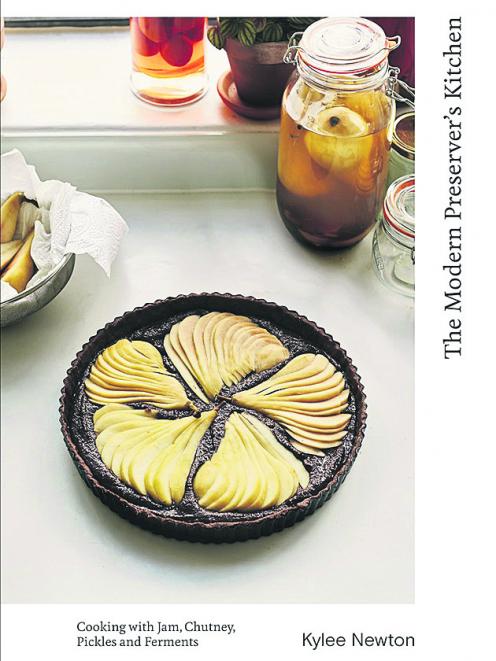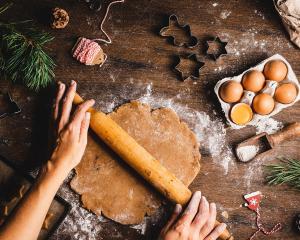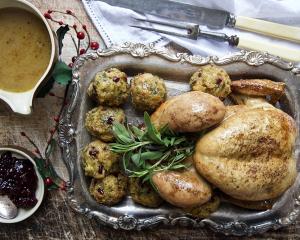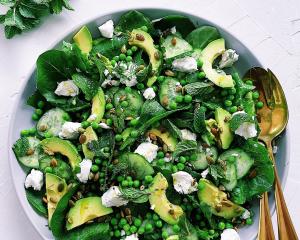

In her latest book, The Modern Preserver’s Kitchen: Cooking with Jam, Chutney, Pickles and Ferments, she continues to showcase her passion for preserving and how some of her favourite preserves dress up her Christmas menu, such as her favourite clementine and whisky marmalade putting the finishing touches to her ham and pavlova.
Clementine and whisky marmalade

Alcohol in marmalade makes for lovely boozy infusions of flavours. If you don’t like whisky then try with the same measure of gin, Campari, tequila or, for that lovely smoky effect, mezcal.
Adding alcohol at the end of cooking when the temperature is slightly over 100degC ensures the alcohol evaporates, leaving behind only the essence, the flavour of the liquor used. You will see it rapidly bubble when you pour it in as the alcohol reacts to the heat and ‘‘burns off’’. This marmalade is therefore safe for children to enjoy.
If alcohol isn’t your thing, then take out the star anise and pop in a couple of bay leaves at the start of cooking. Or you could chop up some rosemary or lemon thyme and stir through before jarring.
MAKES 4-5 × 250ml JARS
1.5kg clementines (or small mandarins)
700ml (3 cups) water
50ml (3½ Tbsp) freshly squeezed lemon juice
2 star anise
1.2kg (6 cups) white granulated sugar
80ml (scant 1/3 cup) whisky
Follow the marmalade process below and add the whisky at the end of cooking when the temperature is slightly over 100degC.
Marmalade process
Place several small saucers in the freezer at least 1 hour before you start. Always begin by sterilising your jars and lids and use them straight from the oven.
Wash and prep your citrus and carefully remove the skin.Lay the skins flat, white sides up, and remove as much of the pith as you can with a very sharp knife. Use this cleaned peel to make zest to add to your marmalade by slicing it into long, thin, super-fine strips, 1mm wide.
Chop the flesh into small cubes, about 5mm-1cm in size, removing the pips as you go and as much of the membrane inside as you can. Cut the other half of the unpeeled oranges in half lengthways and slice very finely with a sharp knife into 5mm-1cm semicircles. If you like less skin in your marmalade, then use more of the cut flesh and less of the cut skin.
Place all of the prepped peel, flesh and semi-circles into a large jam pan with as much of the juice collected on your board while chopping. Add the water and lemon juice and any spices, according to the recipe. Boil on the highest heat, stirring intermittently, for 20-25 minutes, until it has reduced a bit and the peel has softened.
Add the sugar to the pan and stir until it has completely dissolved. Bring back to a rapid boil, then boil for a further 15-30 minutes, stirring intermittently so it does not catch and burn. Keep your marmalade on the highest heat on the largest heat element to achieve the best set.
When it starts to look syrupy and heavier, it’s time to set test/wrinkle test to judge if it’s ready for jarring. When ready to test, remove the pan from the heat, take one of the saucers from the freezer, drop ¼ teaspoon of jam on to the frozen saucer and place in the fridge for 1 minute. Remove the saucer and gently push the marmalade with your finger. There should be a hard or soft wrinkle on the surface for a hard or soft set.
If ready, skim off any foam and stir through any flavourings (if not added at the beginning). Ladle the marmalade or jelly into hot sterilised jars through a wide-mouthed funnel or pour from a heat-proof jug, filling the jars to 2-3mm from the top. Clean the rim with a damp cloth and seal immediately with a hot sterilised lid. Once cooled, date and label.
Marmalades can be stored in a cool, dark place for up to 12-18 months. Once opened, store in the fridge and eat within 6-8 weeks.

I live across the world from my family, so I’ve formed a new family in the UK. My Christmas traditions have changed; however, my mother-in-law is a dream and has adopted some of my mum’s traditions, just so I get a little taste of home at the festive season.
My husband joins in by making a marmalade ham for the ham, cheese and tomato grilled croissants my mum would make every Christmas morning, when we would drink Buck’s Fizz (yes, not the rebranded mimosa) and sit around on the floor to open all our gifts.
Use any marmalade - we just love ours with clementine and whisky; clementines encapsulate the idea of Christmas in the UK for me.
MAKES ABOUT 750g COOKED HAM
11.2kg boneless, unsmoked tied gammon joint (uncooked ham)
250-300ml (11/3 cups) apple cider
2 Tbsp clementine and whisky Marmalade
1 tsp honey
1 Tbsp Dijon mustard
2 tsp orange juice or water
6-8 cloves (optional)
Preheat the oven to 200degC (180degC fan).
Method
Rinse the gammon in cold water. Pour the cider into a roasting pan, then top up with boiling water to a depth of about 3cm.
Place the gammon on a rack that sits above the surface of the liquid, making sure the liquid isnt touching the meat. Wrap a large piece of foil loosely over the meat like a tent, ensuring there is an airtight seal around the edges of the pan but that it doesn’t touch the meat (creating a sort of steam balloon around the gammon).
Bake in the middle of the oven for 50-55 minutes per 1kg of meat. Remove from the oven, remove the foil and rest until cool enough to handle. Snip off the string and use a very sharp knife to slice off the tougher skin without removing any of the fat. Score a crisscross pattern into the fat at 2cm intervals.
In a small bowl, mix together the marmalade, honey, mustard and orange juice and generously cover the scored fat with the mixture. Push the cloves, if using, into the scored fat in an intermittent fashion.
Return the gammon to the oven and bake uncovered for a further 25 minutes or until the glaze is golden.
Rest the meat for at least 1 hour before slicing.
You can make this a few days ahead of Christmas to lighten the cooking prep on the day - it will keep in the fridge for up to 12 weeks.
Notes

When I grew up in the 1980s, pavlova was showcased on many a celebratory table. Classically, the billowing pillow of softness with its slightly crunchy exterior would be topped with lightly whipped cream, freshly sliced strawberries, passionfruit and kiwifruit, maybe a little grated milk chocolate if we were lucky.
Pavlova shouldn’t have a chewy inside. It’s not merely a meringue with cream on top as some recipes might have you think. It should be melt-in-your-mouth soft with a gentle bite to the surface, much like the Russian ballerina it was named after.
As traditions evolve, so has my palate. These days, I like to add citrus, like marmalade, to my pavs and dress them with dehydrated fruits or vegetables and toasted nuts.
SERVES 6-8
4 large free-range egg whites, at room temperature
225g (1 cup plus 2 Tbsp) caster
(superfine) sugar
1 tsp vanilla extract
1 tsp white wine vinegar
2 tsp cornflour (cornstarch)
To serve
200ml (generous ¾ cup) double (heavy) cream, whipped
3-4 Tbsp Clementine and Whisky Marmalade loosened with 2 tsp water
Handful of pistachios or toasted almonds, roughly chopped
Dehydrated carrot twists and orange peel discs (optional)
Method
Preheat the oven to 160degC (140degC fan).
Draw out a 20-21cm diameter circle on a large sheet of baking paper and place on a baking sheet.
In a stand mixer fitted with the whisk attachment or in a large bowl with an electric hand whisk, whisk the egg whites on high speed until light and fluffy, at least 4 minutes. Reduce the speed and add 1 tablespoon of the sugar at a time, whisking to dissolve the sugar each time before adding another. Beat for 10 minutes after the last of the sugar goes in, until its glossy with very stiff peaks. Be diligent with this beating time for better results.
Add the vanilla, vinegar and cornflour and mix on a slow speed until combined. Sprinkle the baking sheet with a little water and spoon or pipe the meringue mixture within the circle shape. Build the meringue up, even out the top and using a spoon make a few peaks as you go to give it some texture.
Reduce the oven heat to 120degC (100degC fan) and bake the meringue for 70 minutes, then turn off the oven and leave cooling inside for at least another 3 hours or overnight. Do not be tempted to open the oven door during this time.
When ready to serve, top the pavlova with the whipped cream, drizzle over the loosened marmalade and sprinkle on the pistachios or toasted almonds.
I like to add dehydrated carrot shavings and sometimes dehydrated citrus or fresh zest.
Notes:
• The pavlova can be kept, covered, at room temperature for up to 1-2 days before decorating.
• If using frozen egg whites, make sure you defrost them first in the fridge for at least 4-5 hours.
• Substitute the marmalade for any other you have, or a stone-fruit jam or curd will be equally delicious. I’ve made this pavlova using a carrot marmalade and a peach jam.
• Caramelize the nuts if you want a sweeter version and have fun with dehydrating fruits or vegetables, such as sliced pineapple, limes, blood oranges, apples, pears, beetroot (beets) or parsnips.













